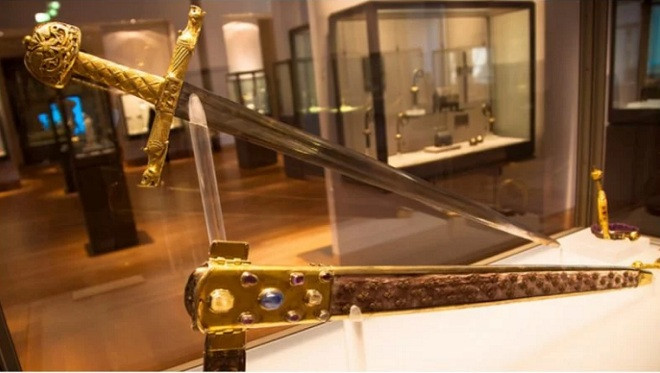The security bar helps European unified owners
This royal sword is one of the most famous legendary weapons in the history of the world, often appearing in the coronation of French kings.
According to the Ancient Origins, Joyeuse is now located in the Louvre Museum, one of the most famous swords in history. It was associated with Charlemagne , the great king of the Franks.

Joyeuse sword is 105cm long, 82.8cm long blade, 4.5cm wide, 2.2cm thick and weighs 1.6kg.
According to historians, Joyeuse 's claim was the legendary weapon that helped Charlemagne the Great (742-814), conquer Europe, merge the Middle and Western Central and Europe. Since the fall of the Eastern Roman Empire, Europe has been divided into various forces until Charlemagne appears.
Legend has it that this sword is so bright that it dazzles enemies on the battlefield. Swordsmen are also immune to toxins.
For hundreds of years, this sword was used in the coronation of French kings.
The sword is united in Europe
The story begins when the sword Joyeuse (meaning fun) was cast by Galas, a famous blacksmith during the 8th century. The sword takes 3 years to complete, bearing the characteristic of a big sword in Europe. Europe, with wide, flat and tapered features.
While returning from Spain, Emperor Charlemagne set up a camp where the sword Joyeuse was crafted and obtained it.
Ever since falling into Charlemagne's hands, Joyeuse quickly gained popularity and was known as the "European conquest sword". Joyeuse is considered a powerful tool to help Charlemagne unite Western Europe in the 9th century and shape medieval European history.

Charlemagne was a change in medieval European history.
In the 11th century, "The School of Roland" - an epic based on the Battle of Roncevaux in 778, described the scene of Charlemagne riding a horse into battle with the sword Joyeuse.
"Charlemagne wore an armor with a white coat, a helmet covered with golden stones and a sword Joyeuse. There was never a sword that matched it, the color of the sword changed 30 times a day."
In the battle of Roncevaux Pass in 778, Charlemagne is said to have lost the legendary Joyeuse sword. Luckily one of his soldiers found it and brought it back.
Charlemagne awarded a large amount of land to this soldier and said: "This place will be built and the person who will be its master. The descendant of the person will be named after the great Joyeuse sword".
Emperor Charlemagne is said to have plugged his unbeaten sword to the ground to mark the location. This may be the origin of the town of Joyeuse at the Ardèche of France today.
Become a French royal treasurer

Joyeuse sword is currently on display at the Louvre museum, France.
No one was sure what had happened to the sword Joyeuse after Charlemagne died in 814. But after about four centuries, in 1270, the sword was used during the coronation of Philip the king at the church. Reims and many kings later.
The sword was kept in the monastery in Saint-Denis until at least about 1505. It was the burial place of French kings after his death.
Joyeuse once again reappeared on December 5, 1793 during the French Revolution. It was last used by the French king Charles X to become the throne in 1824, before being transferred to the Louvre to this day.
The Joyeuse sword kept at the museum has been added to various parts for centuries. The part of the hilt that has been added since the 10th and 11th centuries, the horizontal bar is the second half of the 12th century and the grip has been added since the 13th century.

King Louis XIV carried on his sword Joyeuse.
Earlier, Joyeuse's grip once had a line of Iris flowers but was removed during the coronation of Napoleon I in 1804.
The crossbar of this sword is also very prominent with two dragons with blue stone eyes, which were further crafted in the 12th century. The scabbard was also modified by being made of velvet embroidered with an iris at the coronation ceremony. of Charles X.
The sides of the sword hilt were decorated in a Repoussé style. Scabbard is made of gold and covered with diamond mesh for decoration.
Through the ups and downs of history, Joyeuse is considered a sword that represents the remarkable processing power of the ancient people. Appearing in the coronation of French kings for hundreds of years, the sword has become a symbol of power and domination in French culture.
This is a beautiful sword and it ranks first among the most pirated swords in history.
- Cisco warns of a serious security error CallManager
- Why do cats keep smarter, but dog owners are more likely to survive in society?
- Impulsive people are easy to become good business owners
- Unified trends in physics
- Nortel introduces a 24-hour security solution
- Advanced technology helps Russia secure security at the 2018 World Cup
- Cloud phone ...
- The dog discharges the body with the bite of the rattlesnake instead of the owner
- New security method, soon no need for Password
- Talk with Sony handhelds
- The second network and security laboratory in Vietnam
- The more angry the dog, the easier it is for the owner to commit crimes
 'Fine laughs' - Scary and painful torture in ancient times
'Fine laughs' - Scary and painful torture in ancient times The sequence of numbers 142857 of the Egyptian pyramids is known as the strangest number in the world - Why?
The sequence of numbers 142857 of the Egyptian pyramids is known as the strangest number in the world - Why? History of the iron
History of the iron What is alum?
What is alum?